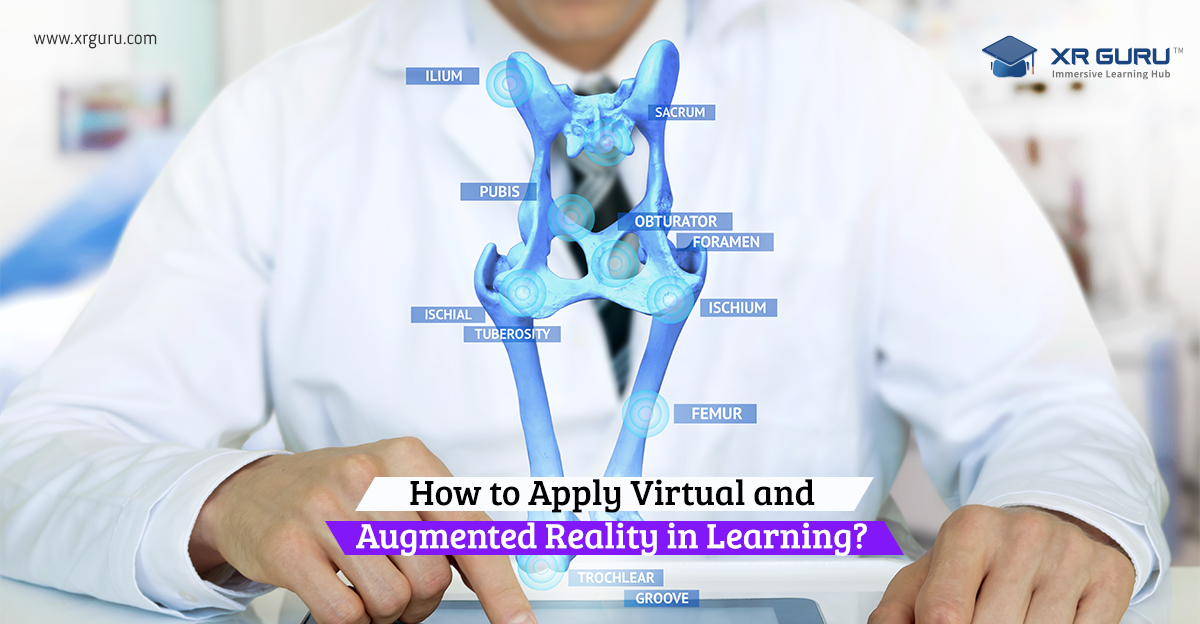How to Apply Virtual and Augmented Reality in Learning?

The objective of education is to help people learn, understand, and remember things. In the digital era, modern gadgets can be a major source of distractions. Hence, innovating new ways to make lessons interactive and improving student engagement has become increasingly difficult. However, utilizing cutting-edge technologies like virtual and augmented reality in learning can make education fun, interactive, and engaging. VR and AR have the potential to revolutionize the way we teach and learn. According to a study, virtual and augmented reality in the education market will grow from $9.3 billion in 2018 to $19.6 billion by 2023, at a Compound Annual Growth Rate (CAGR) of 16.2%. It shows many educational institutions are becoming more receptive to the idea of virtual and augmented reality learning. Read on to learn how to use virtual and augmented reality in learning and their benefits.
How to Apply AR & VR in Learning
Here are some interesting use cases of VR and AR in learning.
1. Experiential Learning with AR and VR
“"Tell me, and I forget. Teach me, and I remember. Involve me, and I learn" - Benjamin Franklin.
This quote by Benjamin Franklin still stands true today. It is well documented that 'learning by doing' produces much better results compared to other learning methods like reading textbooks or listening to lectures. In fact, Edgar Dale's Cone of Experience suggests learners remember 90% of what they do and only 10% of what they read. This study highlights the value of Experiential learning.
VR/AR enables students to interact and connect with the subject matter on a deeper level. It also presents a safe environment for learners to train and hone their skills. With immersive simulations, students can practice high-risk activities such as heavy machine training, fire drills, and medical surgeries without worrying about the risks involved.
2. Create Immersive Lessons
Thanks to the highly immersive nature of AR & VR, students can become completely immerse in lessons. VR/AR in learning presents 3D visuals and interactive digital elements that make teaching complex concepts considerably easier. Also, these simulations and visual 3D models help learners better comprehend the subjects. Imagine if you could travel back in time to study history. Immersive technology in learning makes this possible. With VR/AR learning, you can recreate historic events and bring history to life, making it more interesting and engaging.
3. Facilitate Exhilarating Field Trips
We know field trips require lots of planning and organizing. Furthermore, field trips can be expensive, meaning they are not always affordable for every student. However, with VR/AR, field trips become more affordable, accessible, and engaging. Immersive technologies make traveling to distant or hard to reach locations a reality. For instance, if you want to take your students on a trip to the moon or see a white rhino on an African game safari, you can do so from the comfort of your classroom.
4. Enhance Soft Skills
Incorporating virtual and augmented reality in learning can come in handy for soft skills training. Let us consider public speaking as an example. When it comes to the art of public speaking, becoming more confident and practicing is crucial to delivering better speeches. VR/AR tools help people practice speaking in a more realistic, immersive environment. With immersive simulations, you can master your oratory skills by practicing in front of a large virtual audience, getting feedback, and monitoring your progress over time.
Advantages of AR/VR Learning
Here is how educational institutions and students can benefit from virtual and augmented reality learning.
How AR/VR Learning is Beneficial Educators
· Heightens Student Engagement:
One of the major challenges for modern-age teachers is making lessons engaging and holding the attention of students throughout the lecture. Adopting AR/VR in learning can help educators enhance student engagement levels. Interactive 3D models and immersive simulations can greatly improve engagement levels.
· Multi-sensory Experience:
Virtual and augmented reality learning helps teachers create immersive simulations for students to indulge in a multi-sensory learning experience.
· Transform Teaching:
It can be challenging for teachers to teach complex science topics in a traditional classroom setup. Adopting AR/VR in learning can help instructors teach complex concepts easier through interactive visuals.
How AR/VR Learning is Beneficial Students
· Better Retention Rates:
Virtual and augmented reality in education help students better understand concepts and retain information for a prolonged time to achieve better grades.
· Gamified Learning:
Gamified learning with AR/VR motivates learners and makes the learning experience fun, interactive, and appealing.
· Distraction-free Education:
Since AR/VR learning makes education immersive, it can greatly eliminate distractions which help students better conceptualize and understand.
Takeaway Thoughts
Virtual and augmented reality learning are emerging EdTech trends with the potential to transform education as we know it. Teachers can better capture and hold the attention of their students, while students get the opportunity to visualize concepts and safely practice in a virtual environment. Given the rapid advancements in technology and the resulting significant reductions in the cost of equipment, AR/VR has the potential to revolutionize the education industry faster than anyone could envision. So, what are you waiting for? Gear up for immersive learning - The future of education.
Are you interested in incorporating AR and VR into the learning experience? XR Guru is an immersive learning hub that brings learning to life through immersive experiences. With tools to create unique course content, increase student engagement, and an expansive content library, XR Guru is a one-stop solution to experience immersive learning.
Contact us for a free consultation on your virtual and augmented reality learning needs
Claim Your Free Consultation



Comments
Post a Comment